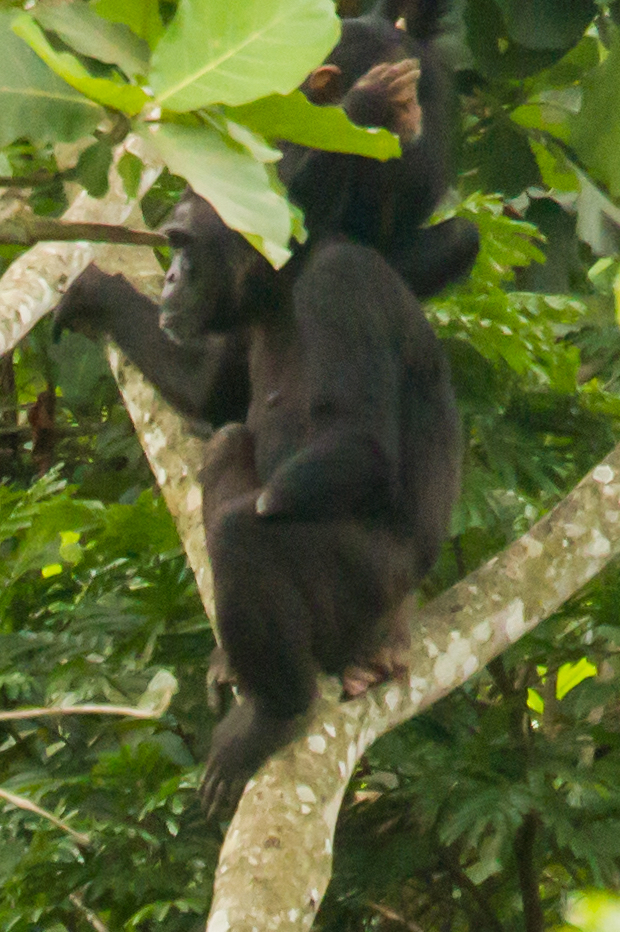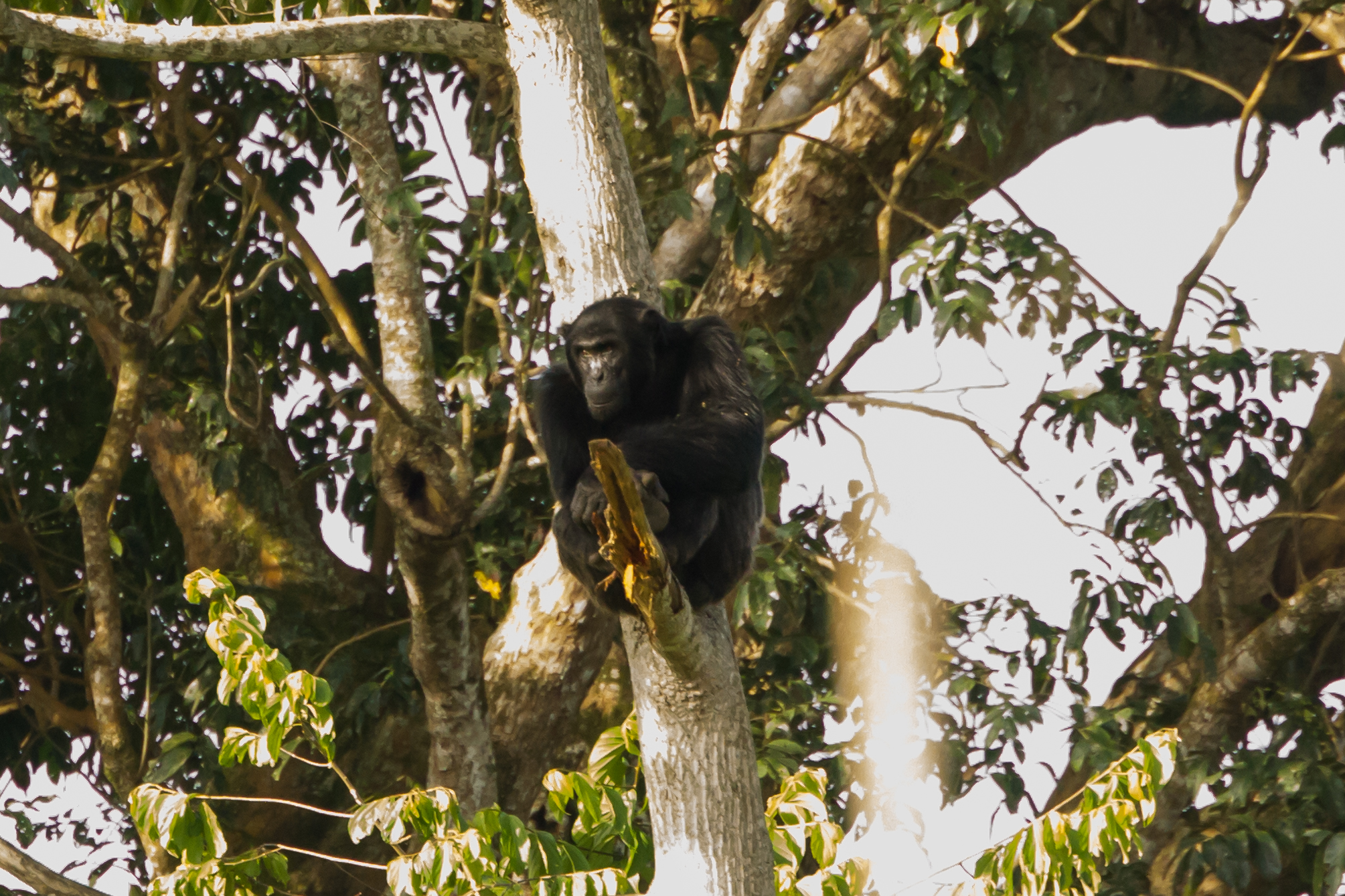
The journey of a PhD student can require navigation through seemingly disjointed settings: from the classroom to the field to the lab, and finally, to the writing desk. After spending years on this journey, I’m nearing the end of my own graduate student career.
Now, as I sit at my desk in Leipzig, Germany, the forest fragments of western Uganda seem very far away. It was there that my team and I spent over a year studying chimpanzees in a human-dominated mosaic of farms and forest fragments.
Chimpanzees in human-dominated habitats
Although this chimpanzee population lives under seemingly abnormal conditions, they represent a growing proportion of this endangered species. Chimpanzees are losing their remaining habitat throughout Equatorial Africa – and quickly. Increasingly, they live outside national parks and protected areas, often in highly degraded habitats.
The extent to which they can persist in such habitats depends on a number of factors, but remains largely uncertain. Numerous studies have been published demonstrating that chimpanzees in human-dominated habitats alter their behavior by incorporating human crop foods into their diet, carefully crossing roads to avoid traffic, and using cryptic or aggressive behaviors to deal with encounters with their human neighbors.
As a PhD student, I’ve undertaken my own research project to help answer a list of key questions, including the number of chimpanzees and whether they are organized into the communities typical of those in protected forests.
The movement of genes
My project focuses on the region around Bulindi, which spans a mosaic landscape about 1,200 km2 in size between the Budongo and Bugoma Forest Reserves. Because Budongo and Bugoma are each home to about 600 chimpanzees, this region as a whole is vital in conservation terms, since it acts as a corridor for chimpanzees and other wildlife, allowing the movement of animals – and their genes – between these protected forest reserves.
Chimpanzees in the forest fragments are understandably wary of humans, so we can’t count them or follow them easily.
Chimpanzees in the forest fragments are understandably wary of humans, so we can’t count them or follow them easily. However, we can collect samples of their dung, which offer a wealth of data regarding individual identity, diet, and health status.
We spent months extracting DNA and genotyping the nearly 900 dung samples we collected, followed by many hours of analysis to calculate the number of distinct individuals represented and estimate the overall population size.
Our results, now published in BMC Ecology, provide genetic evidence of a population between about 260 and 320 chimpanzees in these degraded forest fragments. This is notable given that a 2003 nationwide census of chimpanzees in Uganda identified less than a third as many in this area, citing an estimate of around 70 individuals.
Based on the density at Bulindi, however, researcher Matt McLennan suggested in a 2008 paper that as many as 260 chimpanzees may inhabit the entire region. Our genetically based estimates align more closely with that higher figure, suggesting a larger and more widespread population than that estimated in the nationwide census.
As the days passed in the lab, the chimpanzees I studied seemed to be represented increasingly by identification numbers and strings of genetic data. Eventually, however, we could map the genotypes of distinct individuals according to the locations where we sampled them and the notes we took with each sample. Our experiences in the field finally began to merge with the data, and the disparate aspects of my research project began to converge upon some salient findings.
Glimpses of distinctive individuals
Though we didn’t spend much time in the field directly observing the chimpanzees, we caught glimpses of some distinctive individuals often enough to give them names which we used to identify them. We remembered sampling a female we called Izzy, who was missing her left hand.
This injury was likely the result of a wire snare, an illegal but regularly used hunting device and common cause of injury and mortality among chimpanzees in Uganda. The data revealed that, unbeknownst to us at the time, we collected samples from beneath her nests a few times in different forests throughout her community’s home range.

There was also the adult male Caesar, who we saw on numerous occasions and named after his distinctive facial features that reminded us of the Planet of the Apes character. Once we watched him sit in a tree at the edge of a farm, calmly surveying us and the farmers working nearby. The farmers, in turn, ignored him, accustomed as they were to the chimpanzees who frequented the forest patch nearby.

A week later, as we walked along the forest edge, we stumbled upon loggers cutting down this very tree for firewood. One can only wonder how the chimpanzees themselves reacted upon discovering the loss of yet another tree they once used for nesting, feeding, or just ‘hanging out’.
Valuable habitat
Our findings confirm that there are hundreds of Izzies and Caesars across this human-dominated landscape. Their futures are highly uncertain, however, given the rapid rate of deforestation. In addition to the threat of habitat loss, these chimpanzees come into frequent conflict with their human neighbors, thereby placing the chimpanzees at risk of serious injury and death.
Their conservation is not an easy prospect, but it’s an important one. Unprotected landscapes like this one can be dismissed as lost causes for conservation. Nonetheless, these chimpanzees serve as a vital link between larger populations with more intact habitat.
They are also members of a flagship species, representing a variety of other threatened species in this biodiverse region. Finally, and perhaps most persuasively, their habitat is valuable for human residents as well. The riverine forests these chimpanzees inhabit support critical waterways that are vital to local agricultural livelihoods.
Looming threats of climate change further underscore the importance of investing in these waterways. The loss of these unprotected forests therefore threatens not only the chimpanzees but also the regional economy and ecosystem.
Therefore, while it’s tempting to reassuringly conclude that these chimpanzees are faring much better than predicted, considering the population’s large size and broad distribution, an alternative take-home message seems more apt. These results instead highlight the potential benefits of greater conservation investment in vulnerable unprotected corridor habitats like this one, for the sake of both endangered wildlife and humans.
Comments